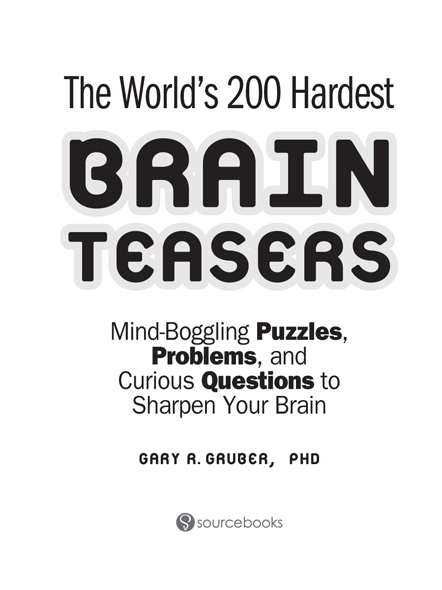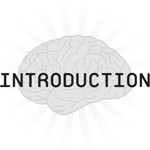World's 200 Hardest Brain Teasers
Read World's 200 Hardest Brain Teasers Online
Authors: Dr. Gary R. Gruber



Copyright © 2010 by Gary R. Gruber
Cover and internal design © 2010 by Sourcebooks, Inc.
Cover design by Larry Nozik/Nozik Design
Cover images © jfelton/iStockphoto.com, kkonkle/iStockphoto.com, tseybold/iStock photo.com, Fred-D/iStockphoto.com, emferr/iStockphoto.com
Sourcebooks and the colophon are registered trademarks of Sourcebooks, Inc.
All rights reserved. No part of this book may be reproduced in any form or by any electronic or mechanical means including information storage and retrieval systems—except in the case of brief quotations embodied in critical articles or reviews—without permission in writing from its publisher, Sourcebooks, Inc.
This publication is designed to provide accurate and authoritative information in regard to the subject matter covered. It is sold with the understanding that the publisher is not engaged in rendering legal, accounting, or other professional service. If legal advice or other expert assistance is required, the services of a competent professional person should be sought.—
From a Declaration of Principles Jointly Adopted by a Committee of the American Bar Association and a Committee of Publishers and Associations
All brand names and product names used in this book are trademarks, registered trademarks, or trade names of their respective holders. Sourcebooks, Inc., is not associated with any product or vendor in this book.
Published by Sourcebooks, Inc.
P.O. Box 4410, Naperville, Illinois 60567-4410
(630) 961-3900
Fax: (630) 961-2168
www.sourcebooks.com
Library of Congress Cataloging-in-Publication Data
Gruber, Gary R.
The world’s 200 hardest brain teasers : mind-boggling puzzles, problems, and curious questions to sharpen your brain / by Gary R. Gruber.
p. cm.
1. Logic puzzles. 2. Lateral thinking puzzles. 3. Word games. I. Title.
GV1493.G77 2010
793.73—dc22
2010002994
Printed and bound in the United States of America.
VP 10 9 8 7 6 5 4 3 2 1
This book is dedicated to the thousands of people from all walks of life who have asked me to put these questions in a book and explain the answers, putting the quest for the solutions at rest.
Table of Contents
The Geometry Problem that Stumped the Nation
The World’s Hardest Brain Teasers
Answer - The Geometry Problem that Stumped the Nation

For years, numerous people have asked me to write this book after they were intrigued with working on these and similar problems that appeared in the various newspapers and airline magazines I write for. The problems in this book are my best and most interesting selections that will get you to think and increase your creativity. They will also help you develop your intelligence so that you will do better on all standardized tests , including the SAT, ACT, GMAT, LSAT, and GRE. Most importantly, they will give you something to look forward to and enjoy aside from your daily routine.
Many entries include an interesting anecdote about the problem and why it is so baffling, so you will get insight into a new way to think. I have also provided detailed explanations (some of which I have never before divulged) for the more difficult problems. Whatever your daily routine may be, the brain teasers in this book will challenge you to use your mind in a highly productive and rewarding way.
MY STORY
When I was in fifth grade, I had to take an IQ test. I scored 90, which is below normal and considered “dull.” Although I was not told my IQ, I noticed that my teachers were not paying much attention to me and were patronizing me as if I were stupid. Later, as friends of mine were skipping grades, I was routed to the “dull classes,” which embarrassed me and made me feel inferior. I felt as if I would never get far in life.
I was in seventh grade when a math teacher at my junior high school in Brooklyn, New York, told my father that he was shocked that I had only a 90 IQ. To my teacher, I seemed much smarter than that. My father was shocked to learn that I had scored a 90 on the IQ test and obtained an IQ test that was currently being administered. He gave me the test.
However, instead of actually taking it (as I had before), I started looking the test over to see what had caused me to get such a low score. This started my fascination with testing and critical thinking. I realized that certain thinking skills were being tested and that a person could actually develop those skills and hone them. I also noticed that there was a generic process to problem solving and thinking. This process was based on extracting something curious from a problem and using that to find the rest of the solution. This process provided the mechanism to think by “synthesizing” rather than just panic and rush to find an answer. As my school career unfolded, I increased my IQ to 126. I then increased the development of my thinking skills and obtained a 150.
I developed an obsession with seeing how problems can be solved. I eventually got accepted into an elite high school, and I started commenting on teachers’ exams by noting on my paper, “This question could be made more interesting by adding so and so,” or “This is a poor question; use this instead of that.” Most of my teachers did not find this amusing (I even got detention for this behavior), but a few did—the ones who had a real interest in the learning mechanism. I started to become fascinated in how nature works, why things work the way they do, and how problems can be solved. This launched my interest in physics.
But after receiving my PhD, teaching, doing some high-powered research in physics, and even getting invited all over the world to lecture on some of the theories I developed, I realized that there was a much more serious problem to solve. There were all these young people out there who were branded like I was—dull—and were not given an opportunity to show their true talents and perhaps even genius. I felt like I was living in Thomas Gray’s poem “Elegy Written in a Country Churchyard” in which he writes, “Many a flower is born to blush unseen and waste its sweet fragrance on the desert air.” I realized I had a mission in life. There are all these people out there who could be great scientists, journalists, or other professionals, people who could develop their talents and become passionate about their life’s work and provide us with the breakthroughs we need so much. Therefore, I turned my interest and passion into the quest for how people can solve problems and learn, and how they can enjoy and develop a passion for learning and problem solving. I devoted my life to test taking, test development, critical thinking, and learning. And to my amazement I noticed, after thirty years of research, that most if not all strategies for thinking, learning, and problem solving are based on common sense and not racking your brain.

Some time ago, I wrote an article titled “Are You a Genius?” that was published in newspapers all over the country. It was a twelve-question test to determine genius IQ. I received hundreds of letters from readers who could not solve the last and rather simple-looking geometry question. When I was a high school student in New York, it took me three hours to solve this problem. However, forty years later, even after being able to write thirty books on the subject of test preparation and thinking, even I could not solve the problem—and it was driving me crazy! Was I getting stupider as the years passed?
So I decided to reprint the twelve-question test, and if someone got all twelve questions right, they would be called a super genius. I was hoping someone would be able to solve the last question and then tell me how they did it. I didn’t get any answers, but I did receive tons of letters asking how the twelfth problem could be geometrically solved. People at the highest levels in math at major universities, government agencies, you name it, could not solve the problem.
Then I got an urgent call on a Friday from the
Washington Post
telling me that they were getting hundreds of calls every few hours asking for a solution to the problem. I told them I could not do it. Well, that wasn’t good enough for them. They said I’d better have the solution to them in four days, or else! Or else what? They couldn’t sue me. For forty years I couldn’t solve the problem and now I had to solve it in four days. Didn’t I have better things to do over the weekend? Well, I contacted everyone I knew who was literally a genius in math, including top mathematicians in the country. I contacted fellow math students whom I hadn’t talked to in thirty years, who went to school with me, and who were super math savvy and may have seen the problem. They were all eager to work on it. However, Sunday rolled around and no one responded with a solution. People from NASA, major math departments all over the country, and even the top mathematicians at Educational Testing Service (the company that develops the majority of entrance, aptitude, and achievement tests such as the SAT) could not solve the problem. In fact, one person was completely peeved, having worked 10 hours straight without a solution!
Then as a very last resort, I was able, by researching and making about twenty calls, to contact my old math professor who had given me the original problem to work on thirty years ago. But when I called him (he must have been somewhat senile), he told me that I was late for class and I’d better hand in my assignments. He kept repeating it—what a bummer! The last person on earth who could have given me the answer was incoherent! The next day I frantically called the whiz kids I went to school with who were working on the problem and asked for any hints they thought I might use. Each one of them told me to use my own specific math strategies that I have been writing about for years and using in all my test-preparation and thinking books. For example, in geometry when you want to prove that if two sides of a triangle are equal then the base angles are equal, the strategy you use is to draw a line down the triangle. This works because, almost magically, when you draw something extra, you get something for it—namely more information and an approach to the solution. I never thought about that because I thought this problem was too sophisticated! It was Monday night now and I was working feverishly on the problem using my very own strategies. The morning of the deadline came around, and I had just finished solving the problem. I told this to the
Washington Post,
and they printed a full-page solution—writing me up as “the super genius.”
